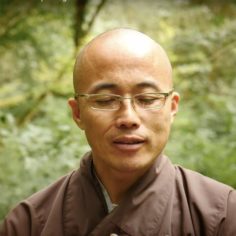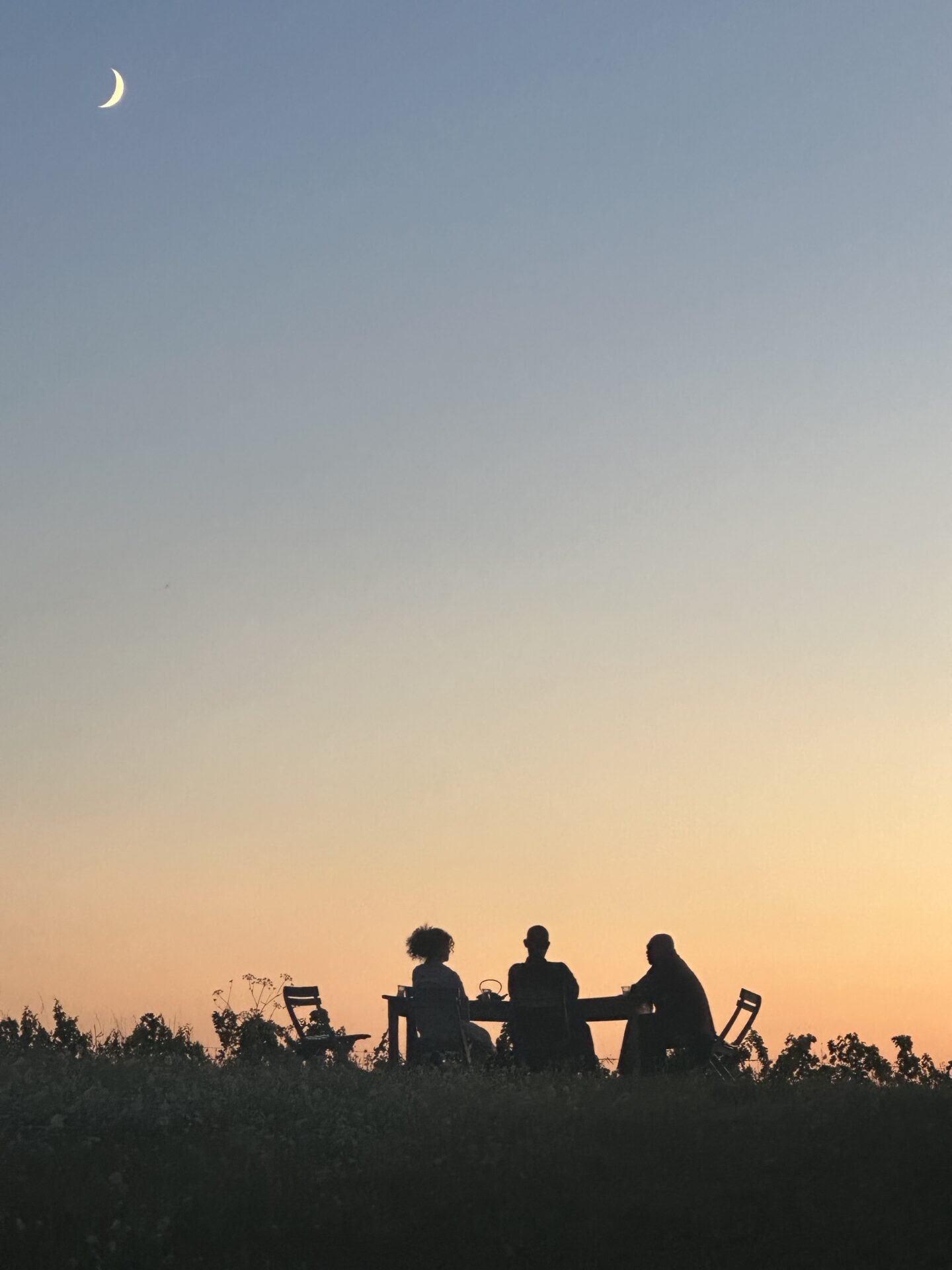Brother Pháp Dung outlines Thầy’s aspiration and vision for residential spiritual communities as a service and refuge for society.
By Brother Pháp Dung on
Dear Friends on the Path,
Lately, the word village has been occupying my thoughts, prompted by our dear teacher’s use of this word in the name Plum Village, our first practice center in the West that he established.
Brother Pháp Dung outlines Thầy’s aspiration and vision for residential spiritual communities as a service and refuge for society.
By Brother Pháp Dung on
Dear Friends on the Path,
Lately, the word village has been occupying my thoughts, prompted by our dear teacher’s use of this word in the name Plum Village, our first practice center in the West that he established. He used village rather than opting for words like monastery, temple, or meditation center. Many well-known Vietnamese monasteries, such as Thiền Viện Trúc Lâm (Bamboo Forest Meditation Center) or Chùa Từ Hiếu (Compassionate Filial Piety Temple), carry these traditional terms in their names.
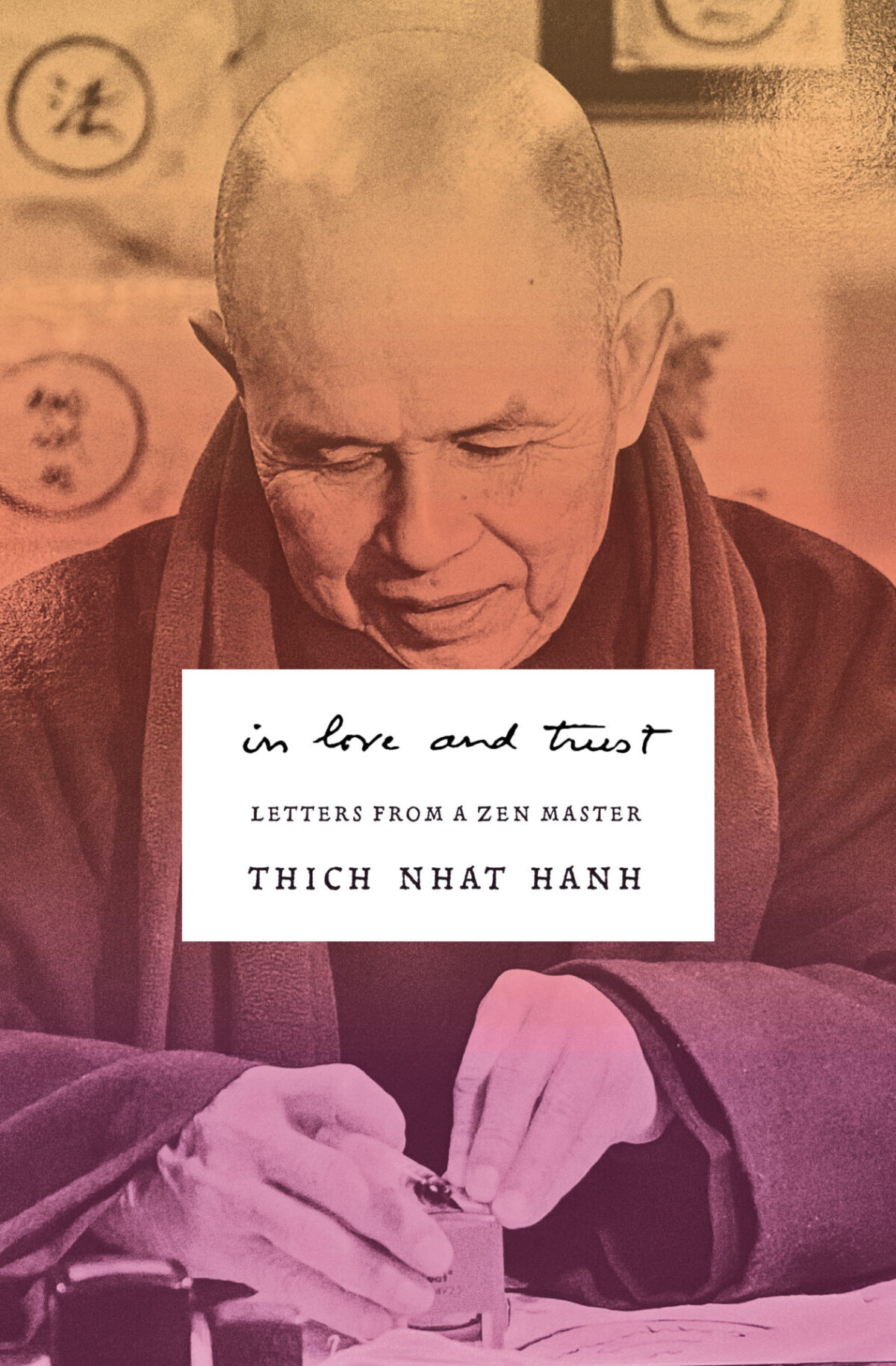
By the time I was ordained in Plum Village in 1998, Thầy was already well known in the West, and Plum Village had become a popular mindfulness practice center, no longer just a gathering place for Vietnamese refugees. Plum Village was all that I knew, and I took its name for granted, not giving it much thought. That was until recently, when I read a letter titled Non-Action, written by our teacher in 1973 to Brother Chau Toan, his younger monastic brother, in which Thầy envisioned a village model rooted in mindful spiritual living, mutual support and kinship, and sustainable ethical livelihood. He also distinguishes his vision for these new communities from past socialist cooperatives by emphasizing that they will be formed through volunteerism and will include a spiritual component.
Sangha building is the most noble task.
—Thích Nhất Hạnh
I am convinced that when our beloved teacher Thầy established our community, he intentionally chose the name Plum Village to reflect his deep aspiration—carried since the war in Vietnam—to create a refuge center far more expansive than a temple or monastery, a progressive model for social development. After the war and his exile from Vietnam, Thầy established Plum Village in the West to embody his vision of a living, dynamic community, where the monastery is just one essential but integrated element of a larger societal vision. This vision, which I call the village way, or làng quê in Vietnamese, aims to build a community that goes beyond traditional religious structures, offering a holistic model for living mindfully and spiritually, close to nature, with mutual support and collective responsibility. I believe his vision was to model the traditional village life in Vietnam, which is evident in his use of the word hamlet, or xóm in Vietnamese, to describe the different communities within Plum Village, such as Xóm Mới (New Hamlet) and Xóm Thượng (Upper Hamlet). These terms, xóm and làng, are rooted in Vietnamese village culture, where they describe the various neighborhoods that make up an interconnected community. Làng means village, or thôn in Sino-Vietnamese, as in Mai Thôn (Plum Village’s formal name), where mai means plum. Quê means countryside and connotes a simple rural lifestyle that is deeply connected to the land, community, and nature. Làng quê is an endearing term that evokes a life of simplicity, interconnection, care, and mutual accountability.
This article seeks to extend Thầy’s message, reflecting on and exploring this notion of the village way, làng quê, and offering, in the end, an invitation to all our sanghas to consider the possibility of forming residential communities as the next level in realizing our teacher’s vision.
Brief background and inspiration
I have always felt empowered and inspired when hearing Thầy, in many of his talks, describe our sanghas as communities of resistance. He saw the sangha as a collective force that resists not only external negativity and the gloomy narratives of modern society but also the internal obstacles that cloud our perception of life’s wonders. Thầy recognized that the world often promotes fear, anger, separation, and consumerism, which blind us to the interconnectedness and beauty of existence and our human species. By cultivating mindfulness, compassion, and collective care, the sangha resists these forces, creating an environment where the wonders of life—love, joy, peace—can be recognized, nurtured, and shared. This resistance is not against people, but against the harmful mental patterns and societal structures that perpetuate suffering, disconnection, hate, and division. He encouraged us to form sanghas and establish practice centers that embody the very spirit of the village way, which he called Communities of Mindful Living.

I feel Thầy’s earliest vision for social change remains as deeply relevant today as it was during the war. As technology and urbanization accelerate, many of us experience growing loneliness, isolation, and despair. Modern society often separates us from ourselves, each other, and Mother Earth, leaving behind a spiritual vacuum, especially in this digital age of gadgets, smartphones, and social media. The mental health of our families and society is inextricably linked to how we have organized our cities, neighborhoods, and communities, as well as to the individualist mindset our culture has long promoted. Neighbors not knowing each other has become the norm; “your side of the lawn is your business, not mine” is a widespread attitude. Meanwhile, the popular media’s agenda continues to fuel division, suspicion, and hatred. It will truly take a village to resist this culture of hopelessness and despair.
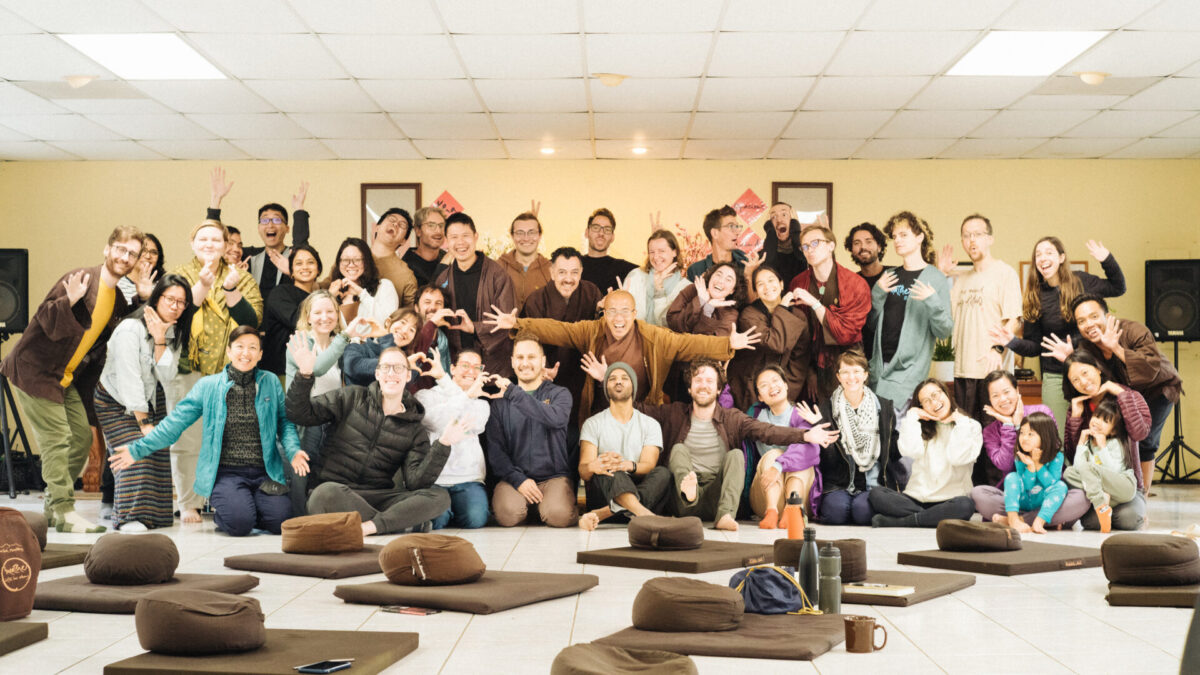
Retreat at Deer Park Monastery June 2025 (Brother Pháp Dung in center); photo by Rob Walsh
Thầy foresaw these challenges and offered a practical, compassionate response rooted in communal living and spiritual practice. As meditation and mindfulness grew in popularity, Thầy emphasized the essential role of the Sangha, which he regarded as equally important as the other two jewels—the Buddha and the Dharma. He continued to lead large retreats, to offer people a direct experience of this village sense of togetherness, despite facing disapproval for such large gatherings. Thầy understood the power of the collective energy for healing and transformation, recognizing the interbeing nature of the individual and the collective. He consistently invited us to embrace the noble task of building the beloved community, a vision shared by Reverend Dr. Martin Luther King Jr. Thầy proclaimed that the twentieth century’s emphasis on consumerist individualism must now give way to the twenty-first century’s call for communities of interbeing—or communities of mindful resistance—if we are to survive as a species. “Sangha building is the most noble task,” he often encouraged us.1
Thầy’s dedication to building community and reviving the Vietnamese village way is not an abstract ideal or romantic nostalgia—it is a practical, embodied model for our times, one that was urgently needed for a country [Vietnam] suffering from the destruction of war. We can only imagine that in times of war, there was no room for ideological dreams—only applicable, real-world solutions that could bring real hope and purpose to the Vietnamese people being tormented. The term làng quê suggests a deep love for the simple countryside values, the tender togetherness spirit of the village collective. This revival does not signal a sentimental return to a pre-modern agricultural past, but rather offers a clear and relevant response to today’s most pressing crises: loneliness, despair, separation, fear, hatred, and climate anxiety.
The village way blends spiritual practices of liberation and collective responsibility with active social engagement and exemplary ethical living. It is the hidden mycelia network that holds the spirit of the village community together. This spirit invites us not only to dream of a better society but also to build it with our hands and hearts, becoming the change we wish to see in the world—a healthy, sane, and compassionate society. In this way, the village or sangha becomes a living Dharma body—a tangible expression of the path of awakening, embodying our Buddha nature—guiding us toward a more mindful, resilient, and inclusive way of life. As Thầy proposed, the next Buddha will not be an individual but will be a community living and practicing together in harmony and awareness.
It is no wonder that Thầy often emphasized two essential topics during retreats: Sangha building and The Five Mindfulness Trainings—community and ethics, or spiritual development alongside social development. These teachings are deeply rooted in the Vietnamese tradition, where the village and temple served as the foundation of social cohesion, collective well-being, and ethical livelihood and compassionate action for the benefit of others. Thầy’s renewal of Buddhism drew from this village soil, returning to these roots not to preserve them unchanged, but to reawaken their power in service to the crises of our times. Buddhism and mindfulness practice must embrace these two aspects if they are to avoid appropriating and individualizing this ancient spiritual tradition.
Thầy first brought this vision for social development to life in wartime Vietnam through the School of Youth for Social Service (SYSS), where he guided thousands of young volunteers in rebuilding and repairing villages destroyed by the war, and in establishing new experimental villages that embodied the integration of spiritual practice, social transformation, and self-determination. Their mission was to help villagers create a new way of life—fostering resilience, equity, and sovereignty while addressing poverty, disease, ignorance, passivity, and disorganization. These communities explored new approaches in economics, healthcare, education, and communal self-governance.2 Each village became a living expression of the Dharma, integrating Buddhist ethics into daily life through mindful social engagement, community care, and sustainable agriculture. In doing so, they offered a powerful model of how contemplative practice and social action could be seamlessly woven together—a vision of Engaged Buddhism that continues to inspire and guide us today. These villages were truly communities of resistance to despair and hopelessness, so much so that the soldiers felt threatened and had to destroy them.
Central to Thầy’s vision is the multifold Sangha—monks, nuns, and laypeople—living in harmony, practicing together, and supporting one another in the collective journey of healing and transformation. While Thầy acknowledged the value of online sanghas, especially in times of crisis like the COVID pandemic, he continually reminded us of the irreplaceable importance of residential communities. Genuine human connection, collective awakening, and long-term spiritual nourishment require real presence and shared space. Virtual communities can inspire and sustain, but they cannot fully replace the transformative power of embodied communal life. Thầy established Plum Village in the spirit of this village way—organizing daily life around mindfulness practices such as sitting, walking, eating, cooking, and caring for our shared spaces with deep awareness and contemplation. He restructured the monastery to function as a true community, where everyone contributes and serves: cutting vegetables, cleaning toilets, sweeping meditation halls, sanitizing dishes, or working in the office—all are expressions of mindfulness and communal care. At the heart of true brotherhood, sisterhood, and siblinghood lies mutual accountability and our shared interdependence. This is also the essence of the village way—showing up together with mindful presence.
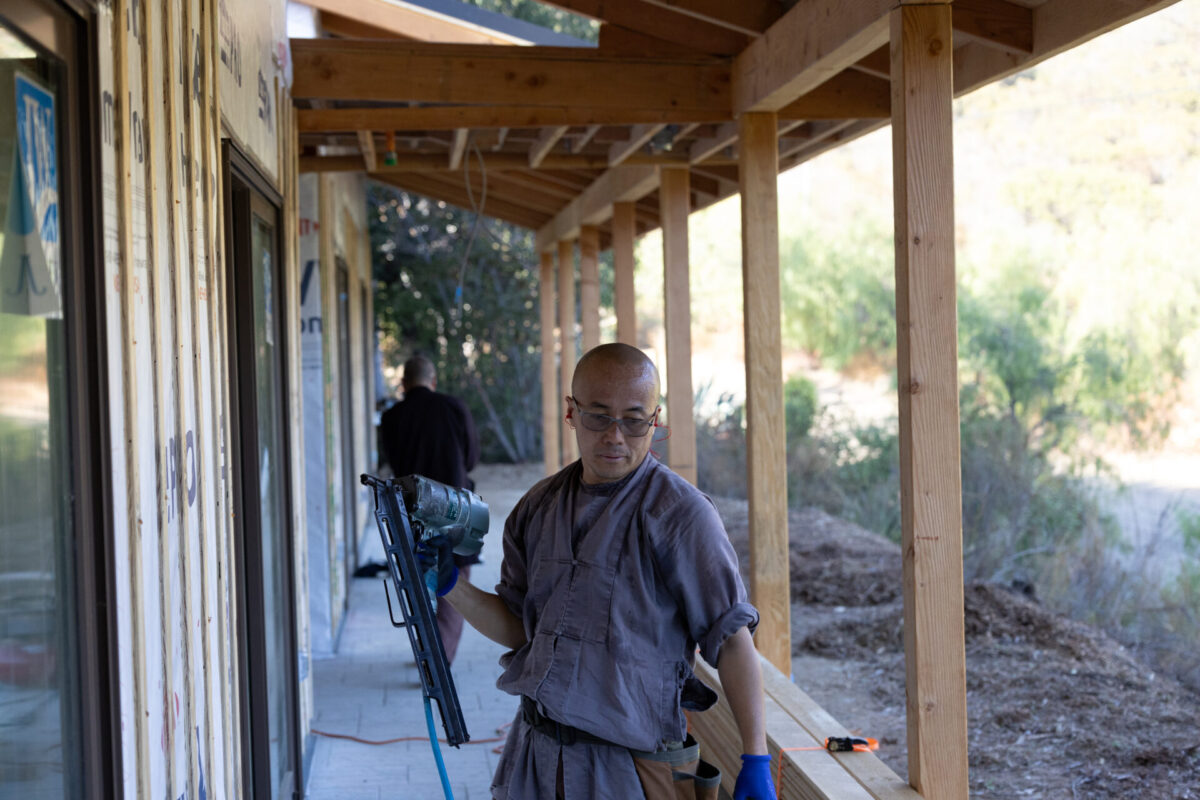
The village way at Deer Park Monastery
At Deer Park Monastery (California, US), we continue to manifest Thầy’s vision in concrete, tangible ways, reviving this spirit of the village way in response to the political, economic, and social challenges of our time, especially for this nation [the United States]. One of our most heartfelt aspirations is to establish a hamlet for lay practitioners at the foot of the monastery, offering an alternative community model deeply rooted in Thầy’s teachings. This residential community will bring together diverse elements identified by our teacher in his 1973 letter and many articles about his vision for the SYSS. The lay hamlet will explore new models in economics, healthcare, education, organic farming, and communal self-governance based on the Plum Village tradition. This will be guided by the monastic community, which will serve as the spiritual beacon for the hamlet, the village temple. A lay friend of the monastery, during a presentation, proposed that this hamlet be called Simplicity Hamlet, where lay practitioners and families can come together to live mindfully and simply, embodying Thầy’s vision of a healthy, sane, and compassionate society.
At the heart of the new lay hamlet will be the Happy Farm, where monastics and lay friends will collaborate to cultivate sustainable agriculture along with mindfulness practices and community living. Communal farming and food production will be an essential bond for all members of the village. So far, in just a few months, we have tilled the soil, sowed the first seeds, drilled a well, and installed solar panels to power a water pump and a 10,000-gallon storage tank, all with the help of many local community members. On our first tilling day, over sixty people arrived to joyfully work the land together. The village life is already a manifested reality, nourishing all who come to serve.
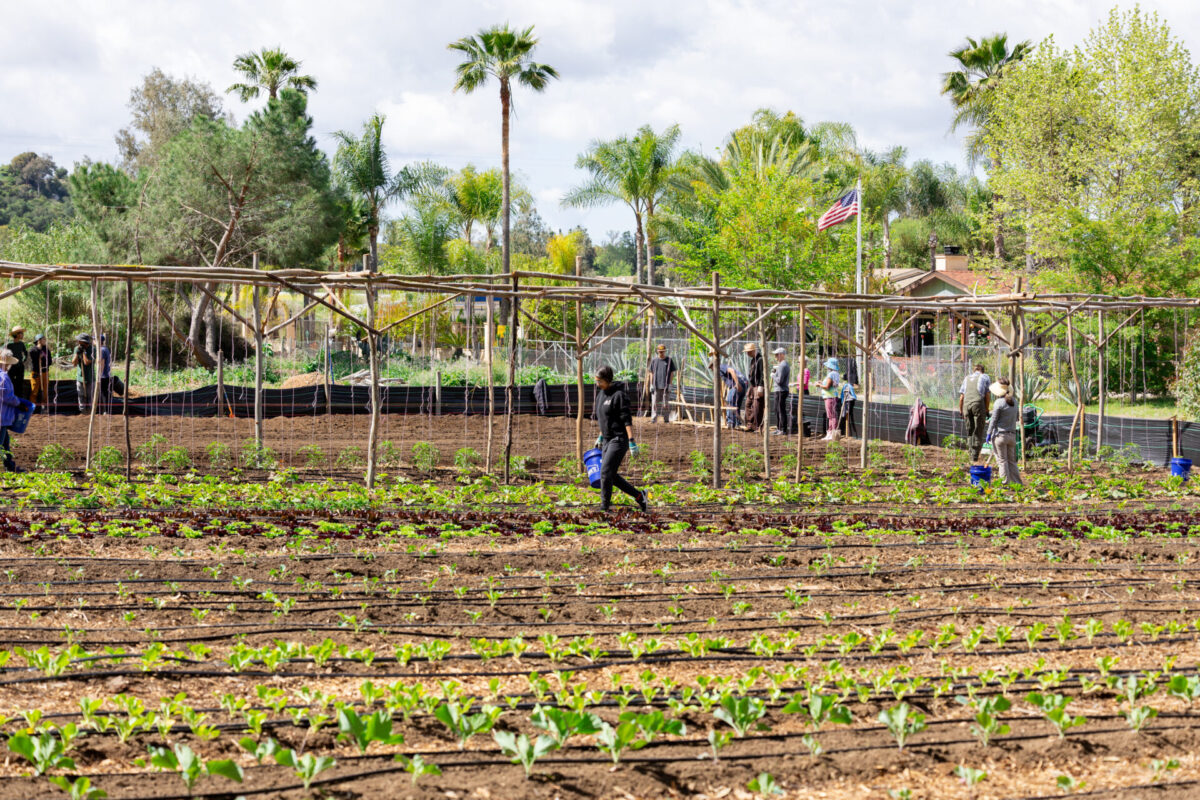
In addition, we have already begun to establish a mindfulness-based primary school in the Plum Village tradition, which will nurture children holistically, with compassion and happiness as its highest goals. This school is a continuation of the Wake Up Schools movement that seeks to foster happiness, resilience, peace, and joy in the field of education in order to support teachers and students, preparing them to meet the challenges of our modern global society. Education will not be limited to the classroom but will flow through all aspects of daily communal life. As we care for the future generations, we also aim to create an elder care center to support and honor the aging generation of our community, enhancing the quality of life through compassionate and life-affirming healthcare. Aging and illness are inevitable aspects of life. Our aspiration is to bring mindfulness practice into this area of community care, improving the quality of life for the elderly and creating a more sustainable way to serve and support them. We also envision craft enterprises and ethical businesses that contribute to the right livelihood and a self-reliant economy of the entire community. In addition, Deer Park aspires to become increasingly self-sufficient, powered by renewable energy, nourished by our own farming, and sustained by local water sources. Mindful stewardship of the Earth and its resources is woven into the fabric of our daily lives and is reflected in all the components of our multifold community—the monastery, the farm, the school, the elder care center, and the entire village hamlet.
Our vision of sustainability is deeply rooted in Thầy’s teachings and vision of the village way, where sustainability is not just about shared resources but also about how we live as human beings and treat one another, and how we relate to Mother Earth. Deer Park aspires to provide a direct, compassionate response to the crises of our time—mental imbalance, climate anxiety, social division, and spiritual disconnection—by embodying a sustainable way of cooperative living rooted in mindfulness, interbeing, and community.
Invitation to the village way
Thầy’s vision for Plum Village and the làng quê, village way, remains profoundly relevant today. His teachings and practical insights continue to guide us toward social transformation, healing, and collective awakening. What Thầy modeled during wartime Vietnam through the SYSS and the Order of Interbeing remains relevant today—imbuing social engagement with spiritual cultivation and community living. Now, more than ever, we invite all our sangha members worldwide to explore, experiment, and help realize this village-based living inspired by our teacher’s earliest vision. The village way is also the Beloved Community envisioned by Dr. Martin Luther King Jr., a mutual aspiration that our teacher has shared with us in his talks.
The village way offers a powerful response to the fast-paced, individualistic, and mechanistic lifestyle of modern urban living. Rather than a nostalgic return to the past, it is a living model of collective awakening, grounded in spiritual practice, mindful community, and shared aspiration to help all living beings. In the Buddhist monastic tradition, this way of life aligns with the Six Harmonies (lục hòa, 六和), which form the foundation for happy, harmonious, and peaceful community living. By harmonizing our shared views, speech, practices, spaces, resources, and aspirations, we cultivate collective compassion, resilience, and interbeing, paving the way for a healthier and more connected future for our children and their descendants.
Below is my attempt to identify some essential elements of the village way, grounded in the Six Harmonies of the Buddhist teachings based on Vietnamese village culture, and drawn from my own experiences of living and practicing in the monastery. These elements will guide our efforts in building vibrant, living communities at Deer Park and wherever else the Sangha gathers to reside and practice together.
Shared spaces and resources
The village way involves living physically together, sharing spaces and resources, and being regularly present, all of which nurture a truly sustainable connection and lifestyle. Village practitioners cooperate and support one another on the path of practice. By showing up with our presence and directly experiencing the rhythm of village life, our sense of kinship is nourished and deepened. Communal spaces and resources—such as shared kitchens, meditation halls, courtyards, farm fields, living quarters, vehicles, food, and other amenities—are central to daily life. These shared spaces and resources foster cooperation and togetherness, further strengthening the collective spirit of the village. This harmony arises from being present bodily and harmoniously for the community. Our spirit alone is not enough; the village must be embodied by real living human beings.
Interdependent community living and mutual support
The insight of interbeing is the beating heart of the village, where everyone’s well-being is interconnected. People help one another, share resources and labor, and take responsibility for their neighbors, offering support in times of need and coming together in times of joy. Village practitioners care for each other as members of one body, where the happiness and suffering of one is shared by all. Interdependence is not just a concept—it is lived and practiced daily through shared service, mutual care, and a deep sense of connection. Kinship, brotherhood, sisterhood, and mutual care are the lifeblood of the community, flowing through its veins. This is the harmony created by sharing love and care for one another.
Shared values and spiritual practice
Shared spiritual values and practices are deeply woven into daily village life. Village practitioners share the same aspiration to be together and engage in the same collective mindfulness practices. The Mindfulness Trainings—whether the Five and Fourteen for lay practitioners or the 250 precepts for the monastics—serve as the foundation of the village. These trainings are practiced, studied, and observed collectively, along with mindful manners, a kind of village monastery etiquette. Spirituality is not separate from daily life, but integrated into every action—how we move, speak, and behave reflects these values and practices. This mindful and ethical way of living is not imposed, but flows naturally from our love and understanding of ourselves and the community in which we live. Spiritual development is the foundation of the village community. The values of kindness, compassion, generosity, and reverence for nature and all beings guide our interactions with one another. All community members are expected to practice Beginning Anew and Shining Light regularly, as well as other mindfulness practices.
Collective responsibility and accountability
In a village community, there is a shared responsibility to uphold the well-being of the entire community, which includes caring for the environment, taking care of the community grounds, supporting all members, and ensuring the thriving of children and elders. Caring for the land and environment becomes a natural expression of this communal responsibility. Every villager both feels needed and needs the community in return. Harmony within the community is rooted in a sense of mutual accountability and responsibility. When we see someone show up, put effort into the practice, and contribute to the collective energy, we are nourished and vice versa.
Spiritual tradition and stable culture
This village way envisioned by Thầy is guided by time-honored traditions that have helped generations in Vietnam, particularly during the Trần and Lý Dynasties, live harmoniously and peacefully together. Our teacher has established the Plum Village Tradition, creating practices, rituals, ceremonies, and monastic customs that help hold, maintain, and transmit the wisdom of our ancestors. A tradition offers continuity and stability, shaping the village community’s identity, shared values and way of life, while gradually adapting to meet the needs of changing times. Spiritual elders are respected as living roots, connecting us to our ancestors and those who came before us, while stories, knowledge, poetry, songs, and wisdom are handed down as seeds for future generations. People work together to preserve these practices, ensuring stability and fostering a deep sense of belonging, interbeing and continuation.
Simplicity and self-sufficiency
Village life is also organized around the principle of simple, shared community living, where service is the foundation of a happy, sustainable, and self-sufficient society. Our goal is to offer an alternative to the capitalistic model, where wealth, status, possessions, and money are no longer the primary measures of value. In a village, life thrives when we live simply, sharing resources, labor, and responsibilities. By focusing on simplicity, we avoid excessive consumption and prioritize what nurtures our physical, emotional, and spiritual health. Through shared living—whether in communal meals or cooperative farming—we build not only a sustainable environment but a culture of interdependence, where the success of one is the success of all. Service to one another becomes a natural expression of love and care. We no longer wait for governments or institutions to change or improve our lives; instead, we empower ourselves to live sustainably as a community and offer a refuge for others.
Dear Dharma friends in our Plum Village sanghas, the village way is not just a vision—it is an invitation that remains profoundly relevant today, as Thầy once offered in his letters and articles to fellow social workers at the SYSS and in the Order of Interbeing. It is a call to walk and explore a different path together in mindful resistance, building real, thriving communities where the Dharma, love, simplicity, and interbeing are woven into daily life and become living models for social transformation and collective awakening. Movements rise and fade, retreats are occasional, and monthly sangha gatherings, while nourishing, can only go so far. But a true, multifold, embodied spiritual community offers the steady, long-term support and continuation that has sustained the Buddha’s Sangha for more than twenty-five centuries. This is a call to carry forward Thầy’s deepest aspiration—born in a time of war and devastation—to create a beloved village: a refuge that heals, nourishes, and renews us as Dharma companions, living in harmony and service to one another, to all beings, and to Mother Earth. In this pivotal time of global uncertainty, digital dependency, distress, and division, let us continue—with each mindful step, each breath, and each act of care—to manifest this village, this làng quê, for our teacher, our ancestors, our children, and all beings.
1 Thích Nhất Hạnh, “True Transmission,” The Mindfulness Bell 81 (2019): 6-15.
2 Thích Nhất Hạnh, In Love and Trust: Letters from a Zen Master (Parallax Press, 2024), 131-143; Thiện Mỹ, Saigon, issues 29-71, 1964-1966. (While still in Vietnam during the war, Thầy was the editor in chief of this magazine in which he wrote many articles to help give hope and direction to the Buddhist youths and the nation by focusing on building villages and empowering and organizing the people.)
Editor’s note: An earlier version of this article was published online and in print that referred to cooperative village models established in Israel as a model for developing Beloved Community. Recognizing the historical and current violence in Palestine and Israel, the editors would like to retract this reference to avoid perpetuating inaccurate or harmful views.
